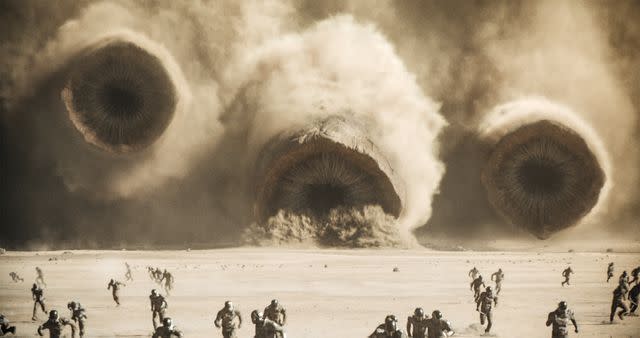Welcome to the Worm Unit: How “Dune 2” pulled off sandworm riding

In order to prove himself to the Fremen, Paul Atreides must be able to ride Shai-Hulud. (That's sci-fi lingo for those giant sand beasts.) The scene was also a big test for director Denis Villeneuve.
The last line of 2021’s Dune film, spoken by Zendaya’s Fremen warrior Chani, was a reminder to viewers that “this is only the beginning.” That idea was underlined by the accompanying image, in which Chani and her new friend Paul Atreides (Timothée Chalamet) watch another Fremen ride a sandworm through the desert.
Even those viewers who hadn’t read Frank Herbert’s original novel or seen David Lynch’s 1984 film adaptation could have guessed that Paul’s own first sandworm ride would have to be one of the showstopper setpieces of Dune: Part Two. But for director Denis Villeneuve and his team, translating this text to the screen meant starting from the ground up.
“In the book, it’s just written, ‘and then Paul rides the worm,’ with no real clues of how a Fremen will actually jump onto a sandworm, this great beast with high speed and tremendous power," says Villeneuve.

Warner Bros. Pictures
Sandworms emerge in 'Dune: Part Two'Designing the sandworm (known as “Shai-Hulud” in the Fremen language) was a major achievement of the last movie. In a 2020 interview with EW, Villeneuve said he and his team sought “to create a lifeform that you will totally believe can survive” in the harsh deserts of the planet Arrakis.
“So from the worm behavior that we had created in Part One, I had to figure out how a human being could approach that: What is the Fremen technique? What do the maker hooks look like? How do you use them?” Villeneuve says. “It required a tremendous amount of [research and development].”
But on a blockbuster film production of this scale, Villeneuve didn’t have time to do all that research himself. He also had to guide his hand-picked stars and top-notch craftspeople through other challenges on different sequences, and couldn’t spare the hours needed to set up every complex shot of the sandworm.
In order to help Villeneuve be in two places at once, the director’s wife and producing partner Tanya Lapointe led a special team that focused solely on the riding scene. They were appropriately called the Worm Unit.

Greig Fraser/Warner Bros.
Zendaya and Denis Villeneuve on the set of 'Dune: Part Two.'“You go to the Worm Unit, and you go up this ladder onto a platform,” Chalamet says. “You get on a little slab of worm — I hope that's never taken out of context — that they practically built, like a scale. And then you get two gripping devices.”
These devices are meant to imitate the special hooks that Fremen use to grip the rough hide of the sandworms. In order to replicate the physical conditions of Arrakis’ desert climate, the actors also had to deal with an industrial fan blowing sand into their faces. But thanks to the careful planning of the Worm Unit, these elements didn’t feel chaotic.
“They figure things out before we get there,” says Zendaya, who did some worm riding herself. “They have already thought about the intricacies of what position your wrists should be in, how your legs should be. So I was like, ‘Okay, if it looks good on them, how do I do what they're doing?’ You try to find the positioning as much as you can.”

Riding the sandworm is how Paul proves to the Fremen that he is capable of leading them against the forces of House Harkonnen and the Emperor. Filming this sequence is how Villeneuve and his collaborators demonstrate that Dune: Part Two can live up to the high standards of their previous film. Needless to say, it required a lot of hard work from everyone involved.
“If it were not for the Worm Unit, I would still be shooting the movie right now,” Villeneuve says. "My main unit was shooting at regular speed, but the Worm Unit would operate at a much slower pace because of the high complexity of the shots. The special effects would require hours to set, even sometimes days to be ready to shoot, which allowed me to swing from one unit to the other without having any impact on the main unit."
The results speak for themselves: “Frankly, it's exactly the dream I had. Every time I see the scene, I’m sincerely moved," says Villeneuve.
Fans will finally get the chance to see the sandworm ride for themselves when Dune: Part Two hits theaters on March 1.
Want more movie news? Sign up for Entertainment Weekly's free newsletter to get the latest trailers, celebrity interviews, film reviews, and more.
Related content:
Anya Taylor-Joy confirms internet rumors about Dune: Part Two role
Breaking down the epic moments and tantalizing teases from the new Dune: Part Two trailer
Read the original article on Entertainment Weekly.

 Yahoo News
Yahoo News 
